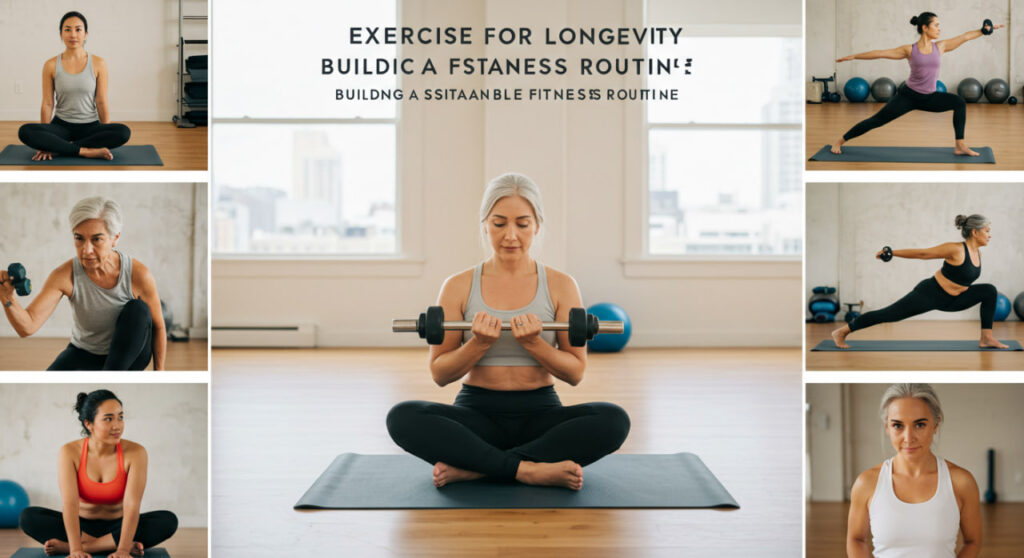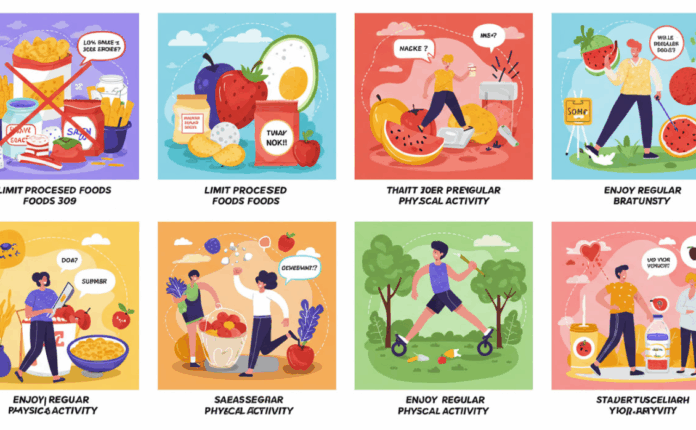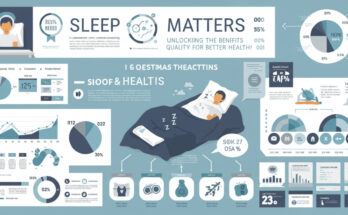In a world obsessed with quick fixes and fleeting trends, the pursuit of longevity through exercise stands out as a timeless endeavor. A sustainable fitness routine isn’t about chasing six-pack abs or grueling gym sessions that leave you dreading the next workout. It’s about crafting a lifestyle that supports your body and mind for decades to come. This article dives into the science-backed benefits of exercise for a longer, healthier life, offering practical strategies to build a fitness routine that’s enjoyable, adaptable, and enduring. Whether you’re a beginner or a seasoned fitness enthusiast, here’s how to make exercise a lifelong habit that fuels vitality.
Why Exercise Matters for Longevity
The Science of Staying Young
Exercise is often hailed as a fountain of youth, and for good reason. Research consistently shows that regular physical activity can slow the aging process at a cellular level. A 2017 study published in Preventive Medicine found that individuals who engage in consistent exercise have a lower biological age compared to their sedentary peers, thanks to the preservation of telomeres—protective caps at the ends of chromosomes that shorten with age. By reducing inflammation, improving cardiovascular health, and boosting mitochondrial function, exercise helps your body function optimally well into your later years.
Beyond cellular benefits, exercise enhances mental sharpness and emotional resilience. The release of endorphins during physical activity acts as a natural mood booster, while studies, like one from the Journal of Alzheimer’s Disease (2020), suggest that regular movement can reduce the risk of cognitive decline by up to 50%. Whether it’s a brisk walk or a yoga session, every step you take is an investment in a longer, more vibrant life.
The Risks of Inactivity
On the flip side, a sedentary lifestyle is a silent thief of vitality. The World Health Organization estimates that physical inactivity contributes to over 3 million preventable deaths annually, linking it to conditions like heart disease, diabetes, and certain cancers. Sitting for prolonged periods—whether at a desk or on the couch—can increase insulin resistance and weaken muscle mass, accelerating the aging process. Building a sustainable fitness routine isn’t just about adding years to your life; it’s about ensuring those years are filled with energy and independence.
Crafting a Sustainable Fitness Routine
Start Small, Think Long-Term
The biggest mistake people make when starting a fitness journey is going too hard, too fast. Diving into intense workouts without a foundation often leads to burnout or injury. Instead, embrace the power of small, consistent steps. Begin with activities you enjoy, whether it’s a 15-minute walk, a dance class, or a gentle swim. The American Heart Association recommends at least 150 minutes of moderate aerobic activity per week, but even 10-minute bursts of movement can make a difference. The key is consistency—choose a routine you can stick with for years, not weeks.

Blend Strength, Cardio, and Flexibility
A well-rounded fitness routine incorporates three pillars: strength training, cardiovascular exercise, and flexibility. Strength training, such as bodyweight exercises or lifting light weights, preserves muscle mass, which naturally declines after age 30. Cardio activities like cycling or jogging improve heart health and stamina, while flexibility exercises, such as yoga or stretching, enhance mobility and reduce injury risk. A 2022 study in Sports Medicine found that combining these elements not only boosts longevity but also improves quality of life by maintaining functional independence.
Sample Weekly Routine
- Monday: 30-minute brisk walk (cardio) + 10-minute bodyweight strength circuit (squats, push-ups, planks)
- Wednesday: 20-minute yoga session (flexibility) + 15-minute cycling (cardio)
- Friday: 25-minute strength training with dumbbells + 10-minute stretching
- Sunday: 40-minute hike or swim (cardio + enjoyment)
This mix keeps workouts varied and engaging, reducing monotony while addressing all aspects of physical health.
Make It Enjoyable
Sustainability hinges on enjoyment. If you dread your workouts, they won’t last. Experiment with activities that spark joy—maybe it’s a Zumba class, a pickup basketball game, or a scenic bike ride. Technology can also enhance the experience. Fitness apps like Strava or Fitbit offer tracking features and community challenges, while smartwatches provide real-time feedback on heart rate and calories burned. Pairing exercise with music, podcasts, or a workout buddy can transform it from a chore into a highlight of your day.
Leveraging Technology for Longevity
Wearable Fitness Trackers
Wearable devices, such as the Apple Watch, Fitbit Versa 4, or Garmin Vivosmart, are game-changers for building a sustainable routine. These gadgets track steps, monitor heart rate, and even analyze sleep patterns, providing insights that help you fine-tune your fitness plan. For example, the Fitbit Versa 4 offers guided breathing sessions and stress management tools, which complement physical exercise by supporting mental health. A 2023 review by TechRadar praised the Versa 4 for its sleek design and accurate metrics, making it ideal for beginners and pros alike.
However, wearables aren’t perfect. Some users find constant notifications overwhelming, and battery life can vary (e.g., the Apple Watch Series 10 requires daily charging). Choose a device that aligns with your goals—prioritize step tracking for walking routines or advanced metrics like VO2 max for intense cardio.
Fitness Apps and Virtual Classes
Apps like MyFitnessPal or Peloton Digital bring professional-grade coaching to your fingertips. MyFitnessPal tracks nutrition alongside exercise, helping you maintain a balanced diet, which is critical for longevity. Peloton Digital offers virtual classes ranging from strength to meditation, perfect for home workouts. A 2024 CNET review highlighted Peloton’s engaging instructors and diverse class library, though the subscription cost ($12.99/month) may deter budget-conscious users. Free alternatives like Nike Training Club offer similar variety with no cost, making them accessible for all.
Overcoming Common Barriers
Time Constraints
“I don’t have time” is a common excuse, but exercise doesn’t require hours at the gym. High-Intensity Interval Training (HIIT) delivers maximum benefits in minimal time—think 15-minute sessions of alternating sprints and rest. Apps like 7 Minute Workout cater to busy schedules, offering quick, effective routines. Schedule workouts like appointments, and integrate movement into daily life—take stairs, walk during lunch breaks, or do desk stretches.
Motivation and Plateaus
Staying motivated over years is tough, especially when progress stalls. Set realistic, measurable goals, like increasing your daily steps by 1,000 or mastering a new yoga pose. Celebrate small wins to maintain momentum. Joining a community, whether through local running clubs or online forums like Reddit’s r/fitness, provides accountability and inspiration. If you hit a plateau, vary your routine—try a new sport or adjust intensity to reignite progress.
FAQ
How much exercise is needed for longevity?
The American Heart Association recommends 150–300 minutes of moderate aerobic activity or 75–150 minutes of vigorous activity per week, plus two days of strength training. Even small amounts, like 10-minute daily walks, offer benefits.
Can exercise reverse aging?
While it can’t reverse aging, exercise slows biological aging by preserving telomeres, reducing inflammation, and improving cardiovascular and cognitive health, as shown in studies like the 2017 Preventive Medicine research.
What’s the best exercise for beginners?
Walking is an excellent starting point due to its low impact and accessibility. Pair it with simple bodyweight exercises like squats or push-ups to build strength gradually.
Are fitness trackers worth it?
Yes, for most people. Trackers like the Fitbit Versa 4 or Apple Watch provide valuable data on activity and health metrics, but choose one that fits your budget and needs to avoid unnecessary features.
How do I stay motivated long-term?
Find activities you enjoy, set achievable goals, and connect with a community for support. Vary your routine to prevent boredom, and use apps or wearables to track progress and stay engaged.



